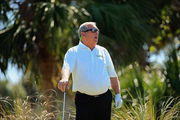
Imago
PGA, Golf Herren The Open Championship – Second Round Jul 19, 2024 Ayrshire, SCT Tiger Woods on the 12th hole during the second round of the Open Championship golf tournament at Royal Troon. Ayrshire Royal Troon SCT, EDITORIAL USE ONLY PUBLICATIONxINxGERxSUIxAUTxONLY Copyright: xJackxGruberx 20240719_pjc_usa_476

Imago
PGA, Golf Herren The Open Championship – Second Round Jul 19, 2024 Ayrshire, SCT Tiger Woods on the 12th hole during the second round of the Open Championship golf tournament at Royal Troon. Ayrshire Royal Troon SCT, EDITORIAL USE ONLY PUBLICATIONxINxGERxSUIxAUTxONLY Copyright: xJackxGruberx 20240719_pjc_usa_476
Seven back surgeries. Multiple knee operations. A near-fatal car crash. For most athletes, even one of these would end a career. For Tiger Woods, they became chapters in golf’s greatest comeback story. The 15-time major champion has turned his medical rap sheet into a testament of sheer willpower, repeatedly defying doctors and critics who said he was done.
Watch What’s Trending Now!
His journey through pain started young and never really stopped. December 1994 marked his first surgery at the age of 18. Stanford University’s rising star had two benign tumors and scar tissue removed from his left knee. Nobody knew then that this was merely the opening act of a three-decade medical drama that would reshape what’s possible in professional sports.
Top Stories
Golf Veteran, 90, Pays Emotional Tribute to Fuzzy Zoeller Days After His Passing

Tiger Woods Unwilling to Let Charlie Woods Down as He Makes Tough PNC Championship Decision

Tour Pro Warns Jon Rahm About DP World Tour Future as LIV Golf Appeal Verdict Nears

Tiger Woods Issues Unfortunate Health Update Following Senior Tour Debut Rumors

‘He Was a Disgrace’: Brooks Koepka’s Ex-Coach Recalls Snapping at LIV Golf Pro Over Attitude Issues

ADVERTISEMENT
Tiger Woods’s injury timeline: From torn ACLs to seven back surgeries
Woods ruptured his ACL in July 2007 while running after the British Open. Most athletes would’ve shut it down immediately. Tiger? He won five of his last six tournaments that season, including the PGA Championship. The torn ligament couldn’t stop him from dominating golf’s biggest stages.
Then came the 2008 U.S. Open at Torrey Pines. Tiger had undergone arthroscopic surgery just two days after finishing second at the Masters. Doctors later revealed he was playing with a torn ACL and two stress fractures in his left tibia. He should’ve been on crutches for three weeks. Instead, he battled through 91 holes over five days.
His final-round 73 forced a playoff with Rocco Mediate. Both players shot 71 in the 18-hole playoff, pushing the tournament into sudden death. On the 19th hole, Woods made par while Mediate found the bunker. Victory was his, but the cost was brutal. Eight days later, he had reconstructive ACL surgery using a tendon from his right thigh. The rest of 2008? Gone.
ADVERTISEMENT
— Tiger Woods (@TigerWoods) October 11, 2025
April 2014 brought Tiger’s first back surgery for a pinched nerve. This marked the beginning of his darkest competitive period. He missed nearly four months and struggled badly upon return. Three additional microdiscectomy procedures were performed between 2014 and 2015. His world ranking plummeted to 1,199 by 2017.
ADVERTISEMENT
Dr. Richard Guyer performed Tiger’s spinal fusion surgery in April 2017. The anterior lumbar interbody fusion at L5/S1 was described as a “bailout procedure.” The surgery eliminated motion at the affected level but provided 60-70% relief from chronic pain. It was Tiger’s last resort after three failed microdiscectomies.
Recovery timelines meant nothing to Woods. Doctors expected a full recovery in six months. Tiger returned to major championship glory in 22 months. The numbers backing Tiger’s comebacks have documented his remarkable resilience through nearly three decades of professional golf.
February 23, 2021, changed everything. Tiger suffered life-threatening injuries in a single-vehicle rollover crash in California. He sustained comminuted open fractures to both the upper and lower portions of his right tibia and fibula. Emergency surgery at Harbor-UCLA Medical Center inserted a rod, screws, and pins into his shattered leg.
ADVERTISEMENT
Amputation “was on the table” according to Woods himself. The possibility? “Damn near 50/50.” Dr. Anish Mahajan treated the significant orthopedic trauma during emergency surgery. Tiger’s right ankle also suffered significant damage, requiring surgical release of the muscle covering to prevent compartment syndrome.
Rory McIlroy watched his idol suffer. “At this stage, I think everyone should just be grateful that he’s here, that he’s alive, that his kids haven’t lost their dad,” McIlroy said after Tiger’s 2021 car crash. Golf had become secondary to survival.
March 2025 brought another setback. Tiger ruptured his left Achilles tendon while training at home. Dr. Charlton Stucken performed minimally invasive repair surgery at the Hospital for Special Surgery. “The surgery went smoothly, and we expect a full recovery,” Stucken announced.
ADVERTISEMENT
Then came October 2025. Tiger underwent lumbar disc replacement surgery for a collapsed disc at the L4/5 level. Dr. Sheeraz Qureshi performed the procedure at Hospital for Special Surgery in New York. This marked Tiger’s seventh back surgery.
Tiger Woods’s comeback victories: When ratings soared and Augusta roared
Golf viewership numbers tell the story of Tiger’s absence. Television ratings fell 18% during his injury-plagued years from 2014 to 2017. Tournament attendance dropped 11% during the same period. The 2014 Masters posted its lowest rating since 1993. The sport needed him back.
ADVERTISEMENT
September 2018 brought redemption. Tiger captured the Tour Championship at East Lake for his 80th PGA Tour victory. He hadn’t won in 1,876 days. His final-round 71 sealed a two-shot victory as approximately 15,000-20,000 fans flooded the 18th fairway. “I was having a hard time not crying on that last hole,” Woods admitted afterward.
The 2018 Tour Championship drew a 5.21 overnight rating, up 206% from 2017 when Tiger wasn’t playing. NBC recorded 18.4 million streamed minutes on Sunday, up 561% from the previous year. Tiger’s presence meant everything to golf’s bottom line.
Then came April 2019. Augusta National. Tiger entered the final round trailing by two shots. Francesco Molinari held the lead until disaster struck at Amen Corner. Molinari’s double bogey at the 12th hole changed everything. Another water ball at the 15th sealed his fate.
ADVERTISEMENT
Woods seized the moment. He birdied the 15th from eight feet. His tee shot at the 16th nearly found the cup, stopping just three feet away. Two putts for par at 18 secured his fifth green jacket. The 2019 Masters drew 15.35 million combined viewers between live and encore telecasts. Peak viewership hit 18.3 million during Tiger’s victory moment.
“I couldn’t be more excited. I’m at a loss for words,” Tiger said through tears. “To have my kids there, it has come full circle. My dad was here in ’97; now I am a dad.” The 11-year major drought was over. The 14-year Masters gap had closed.
Phil Mickelson left Tiger a handwritten note on a cocktail napkin: “Tiger, so impressive! What a great tournament you played! So happy for you!” The longtime rival recognized history when he saw it.
ADVERTISEMENT
Michael Jordan called it “the greatest comeback I’ve ever seen.” The basketball legend added, “I never thought he’d get back physically. He didn’t think he’d get back physically. But he did it.”
The golf industry felt the financial impact of Tiger’s absence. Master’s ticket prices dropped 66% on the day of his 2014 withdrawal announcement. Corporate hospitality bookings declined 25%. Nike lost approximately $3-4 million in exposure value during the 2013 Masters without Tiger coverage.
The 2022 Masters proved that Tiger’s determination transcends results. Just 14 months after his near-fatal crash, he competed at Augusta National. His rounds of 71-74-78-78 resulted in a T47 finish, 13-over par. The weekend rounds of 78 were career-worst Masters scores at the time. Yet he completed all 72 holes.
Visible limping plagued his weekend play. Heat packs covered his back between holes. He began his stretching routine at 4 AM to prepare. “For not winning an event, yes,” Woods answered when asked if this ranked among his most outstanding achievements.
Tiger’s mental fortitude: The mind that refuses to quit
Tiger’s philosophy remains unchanged: “I’ll play as long as I can play and I feel like I can still win the event.” He expanded on this in 2013: “For me, I always want to win. So if I can’t win, why tee it up? That’s just my own personal belief.”
His mental approach during the 2008 U.S. Open revealed his competitive edge. “First of all, I didn’t want to show anybody that I was hurt. You never want to show your competitors that you’re hurt. I don’t want them to get that mental edge. Oh, he’s down. You always pick yourself right back up.”
McIlroy’s texts from Tiger’s hospital bed revealed his fighting spirit. “He was the first one to text me and be like, ‘What’s going on here?'” McIlroy shared after struggling at Bay Hill. “Even from the hospital bed, he’s still giving me some heat.”
Congratulations to our boss on winning the Tour Championship today, marking it his 80th PGA Tour victory and a comeback for the ages. – TGR #TW80 pic.twitter.com/A0ZR8WceRc
— Tiger Woods (@TigerWoods) September 23, 2018
Jordan Spieth witnessed Tiger’s competitive fire firsthand. Following Tiger’s loss in “The Match,” Spieth revealed his reaction: “Tiger, first off, he doesn’t lose very often. He hasn’t in his whole career.” When ribbed about the defeat, Tiger “just smiled…saying F off.” The killer instinct survived every surgery.
Tiger’s work ethic defines him. “People don’t understand that when I grew up, I was never the most talented. I was never the biggest. I was never the fastest. I certainly was never the strongest. The only thing I had was my work ethic, and that’s been what has gotten me this far.”
No timeline exists for his return. His world ranking sits outside the top 300. He hasn’t played competitively since missing the cut at The Open Championship in July 2024. The December 2025 Hero World Challenge proceeds without him. His participation in the PNC Championship with his son, Charlie, remains uncertain.
Yet dismissing Tiger Woods remains foolish. When Colin Montgomerie suggested retirement in 2024, Tiger fired back: “Well, as a past champion, I’m exempt until I’m 60. Colin’s not. He’s not a past champion, so he’s not exempt from the competition. So he doesn’t get the opportunity to make that decision. I do.”
His legacy as golf’s ultimate comeback artist stands secure. Each surgery represents another chapter in an impossible story. Each return defies medical probability. Tiger Woods doesn’t just overcome injuries. He transforms them into fuel for the subsequent resurrection. Whether October 2025’s disc replacement marks his final surgery or simply the latest obstacle remains golf’s most compelling question.
ADVERTISEMENT
ADVERTISEMENT
ADVERTISEMENT

.png?w=50&h=50)
